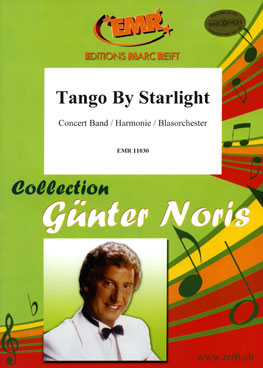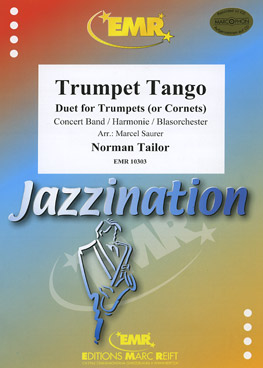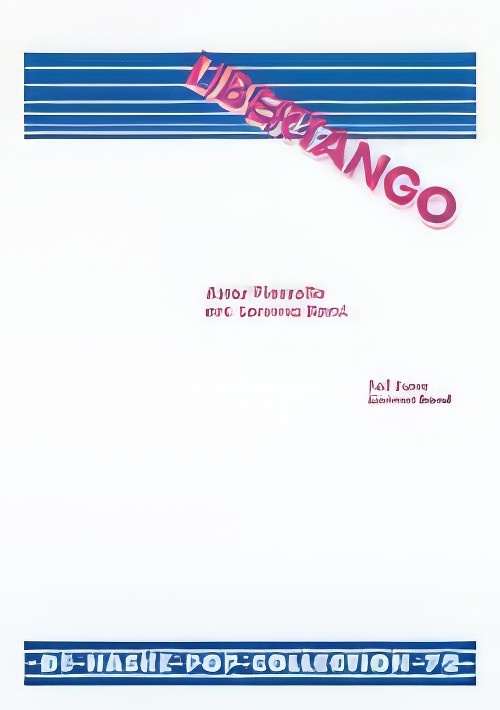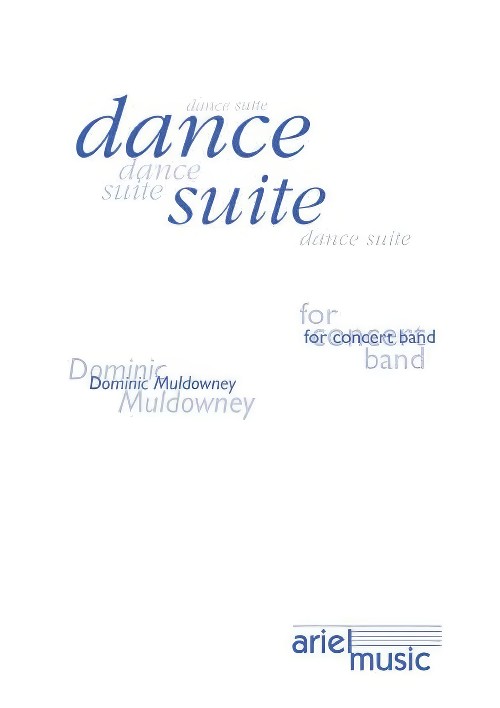Results
-
 £100.00
£100.00TANGO BY STARLIGHT (Advanced Concert Band) - Noris, Gunter
Estimated dispatch 7-14 working days
-
 £44.95
£44.95TASSIE TIGER TANGO (Programme Concert Band) - Perrin, Roger
A 'fun piece' which contrasts busy Latin American rhythms with smooth melodies. Performance time 3'20" Grade 2-2.5
Estimated dispatch 7-14 working days
-
 £100.00
£100.00TRUMPET TANGO (Trumpet Duet with Intermediate Concert Band) - Tailor, Norman - Saurer, Marcel
Duration: 3:15
Estimated dispatch 7-14 working days
-
 £113.30
£113.30Moderate Dances - Angelo Sormani
This piece is a tribute to dance music, especially passionate, intense and meditative dance music. "Moderate Dances" is divided into three movements: a "Tango", a "Slow Waltz" and a "Bossa Nova". Each movement and each dance has its own particular characteristics but, when combined, these different rhythmic beats and times give the piece a feeling of completeness and uniformity. The Tango started to flourish in the suburbs of Buenos Aires in around 1880. There is still some doubt as to its origins, which may be Cuban (Habanera) but are probably African. It was most popular in Argentina and Brazil: here the male protagonist was originally the "gaucho" with his inseparable guitar, later to be replaced by the proud, elegant "compadre". By around 1910 the Tango had spread to Italy and France. New clubs opened, where the upper classes could watch and dance the Tango. Here the dance also underwent some rapid transformations. The exaggerated and extravagant gestures and body movements disappeared. Slow, gliding steps replaced the old rotational movements. The women's red ankle-boots and the partners "staring into each other's eyes" accentuated the erotic nature and sensuality of this dance. So much so that, in 1913, the German government banned soldiers from dancing the Tango. Those who broke the law were immediately discharged from the army. From a strictly musical perspective, the basic instruments were a flute, a harp (the diatonic harp typically played by the Indians of Paraguay) and a violin, or flute, guitar and violin or even clarinet, guitar and violin. These instruments were easy to transport, ideal for playing at parties, in the streets and in courtyards. The musicians played by ear, frequently improvising: there were no scores, no records, which is the main reason why it is impossible to trace the Tango back to its exact origins. However, the Tango's evolution (and growing popularity) was once again fostered by its fundamental ability to absorb "other" cultures, languages and sounds. And it was the arrival of the "bandoneon" (an accordion-like instrument that was invented in Germany and brought to Rio de la Plata by some immigrant), which replaced the flute, that marked the beginning of the Tango's huge success outside Argentina. A number of talented composers, above all the great Astor Piazzola (1921-1992), transformed the bandoneon from a simple accompanying instrument to a solo instrument that was to become the distinguishing feature of the 20th century Tango. The Slow Waltz originated from the Waltz, the typical dance of the Bavarian and Tyrolese peasants in the 1700s. It was composers like Johann Strauss, father and son, who carried the Waltz to its zenith in the 1800s, creating the sensual and melancholy yet joyful and charming dance we are all familiar with. When the Waltz first became popular in Germany, the members of respectable society were shocked at the closeness of the dancing partners, who had always previously danced apart. The main difference between the Waltz and Slow Waltz is that the latter has a slower, more expressive rhythm: the men wear tails and the women wear ball gowns decorated with beads and feathers and couples dance in graceful rotational movements. "Bossa Nova" is the title of the last movement in the piece. Jobim, the great Brazilian musician, described this musical genre as a combination of modern Jazz and Samba. Bossa Nova means "new wave". This was the name of the artistic and musical movement that evolved in Brazil in the late Fifties and was extremely popular throughout the Sixties. The songs are usually about love or social matters, drawing inspiration from the slums of Rio De Janeiro and the lives of their inhabitants. Bossa Nova, with its original compositions and the artistic talent of its musicians, also became hugely popular in the United States and Europe, and top Jazz musicians (Ella Fitzgerald, Stan Getz, Bob Cooper, Charlie Bird, Sonny Rollins, Dexter Gordon, Dizzy Gillespie) started to include Bossa in their repertoires.
Estimated dispatch 7-14 working days
-
 £84.99
£84.99Libertango (Concert Band - Score and Parts) - Piazzolla, Astor - Bocci, Lorenzo
Astor Piazzolla (1921-1992) revolutionised the tango: with his bandoneon (instrument similar to the accordion), he dared where others did not. During his career, which started in the 1950's, Piazzolla produced a real revolution, developing the musical structure of the tango in a truly innovative way. He also understood from the very beginning the huge expressiveness of tango. In recent years the tango has again become extremely popular and this arrangement of one of Piazzolla's most famous pieces will be an instant hit with both band and audience.Duration: 3:15
Estimated dispatch 7-14 working days
-
 £160.00
£160.00DANCE SUITE (Concert Band) - Muldowney, Dominic
Includes:1. Hey2. Pavane/Waltz3. Polka4. Waltz/Galliard5. Tangos6. Break-DanceDance Suite displays a variety of historical dance forms from a twentieth century viewpoint. The six dances move forward historically from the ancient Hey, through Waltz and Polka, to the sophisticated Tango and the jazz tradition. The rhythm that typifies each dance is constantly under attack, sometimes from a different dance style altogether. These intrusive elements are most obvious in the final dance and prompts the double meaning of the title.I. HEYHey is constructed like a mediaeval motet, where the main blocks of material are rhythmically unconnected to one another. The percussion is the most disconnected of all and seems to have arrived from a Chinese carnival. The scoring alludes to the eight, four and two foot pipes of a baroque organ.I. PAVANE/WALTZAfter a nod in the direction of Dowland's Lachrimae Pavan, the piece seems to wander to and fro between the 16th century and the 19th century world of the Lehr waltz.I. POLKAThe Polka is derived from a four bar fragment found in Stravinsky's sketchbook for The Rite of Spring above which is written: "Dieppe Polka".I. WALTZ/GALLIARDThis is a reversal of the date-shift process in the second movement, in that the wandering goes backwards rather than forwards, particularly to the William Byrd of the Fitzwilliam Virginal Book.I. TANGOSA slow sentimental tango is sandwiched between an abstract deconstructed one, both of which are developed in Dominic Muldowney's opera The Voluptuous Tango.I. BREAK-DANCEBreak-Dance is the fastest, hardest and strangest movement. Its exuberance fractures the texture, which slowly crumbles midway through the movement, only to be resurrected mirror fashion. The piece is a species of palindrome with no true centre, hence: "Break-Dance".Conductors are free to make a selection from these dances for festival or competition programmes, when limited performance time is available.
Estimated dispatch 7-14 working days
-
 £107.50
£107.50Dulcinea (Symphony No. 3, 'Don Quixote,' Mvt. 2) - Robert W. Smith
The second of four movements in Robert W. Smith's epic work, Dulcinea tells the tale of Don Quixote's adoration of the ideal woman. Written in a sultry 5/4 tango, the audience will hear the haunting melody and feel the passion of Cervantes' knight-errant as he proclaims his love for Dulcinea de Tobosa. Featuring an English horn solo that is liberally cross-cued throughout, the initial melody gives way to the most powerful of statements before returning to the tango in a quiet, yet startling ending.
Estimated dispatch 7-14 working days
-
£58.50
Funtango - Chris Sharp
This tongue-in-cheek approach to the classic tango will keep your percussion section busy with lots of Spike Jones type comic effects, including siren whistle, bulb horn, slapstick, vibraslap, guiro, and clapping. To aid with performance flexibilty, an alternate optional snare drum part is provided for more accomplished players. This is one "fun tango" that literally has all the bells and whistles! (2:10)
Estimated dispatch 7-14 working days
-
 £349.99
£349.99Symphonic Dances - Yosuke Fukuda
Symphonic Dances for Wind Ensemble was commission by the Central Band of the Japan Air Self Defense Force. The suite's five movements present "dances of the world". While the energetic quality and spirituality of each dance should be captured, the collection is still intended to entertain. Each movement is complete and can be performed accordingly.I. Renaissance DancesAn homage to European flavor and style from the time of Gervaise, Susato and Praetorius, after the introduction, the steps of courante, pavane, galliard, and branle appear. Please perform with vigor and contrast!II. TangoThis section is more an earthy and piquant Argentine romance than an elegant continental tango. Perform the alto saxophone theme and solis for each section very passionately!III. HoedownHere is the scene of the rodeo and a free-spirited western swing feel. The introductory clarinet solo can be done ad libitum. Maintain the mood by swinging slightly throughout. Present this movement playfully!IV. Spirituals (Bon-Odori-Uta)This is a requiem on the Bon-Okuri ceremony guiding ancestors back to the spiritual world. The initial piccolo motif repeats a chant in the rhythm of bon odori (a bon dance) and develops as a variation on Owara-bushi, a beautiful folk song from Toyama prefecture. The traditional bon odori have evolved into summer festival entertainment.V. Belly DanceThe belly dance is typically Arabic, its music performed by strings and drums.All should play with passion and flamboyance and a sense of bacchanalia and abandon. Employ a heavy sense of rhythm, also with a "Darbuka" (traditional Turkish goblet drum) if possible. Additionally, a "big-bang" coda is not only allowed, but encouraged!(Yosuke Fukuda)
Estimated dispatch 7-14 working days
-
 £79.20
£79.20Dulcinea (Symphony No. 3, 'Don Quixote,' Mvt. 2)
The second of four movements in Robert W. Smith's epic work, Dulcinea tells the tale of Don Quixote's adoration of the ideal woman. Written in a sultry 5/4 tango, the audience will hear the haunting melody and feel the passion of Cervantes' knight-errant as he proclaims his love for Dulcinea de Tobosa. Featuring an English horn solo that is liberally cross-cued throughout, the initial melody gives way to the most powerful of statements before returning to the tango in a quiet, yet startling ending.
Estimated dispatch 7-14 working days
